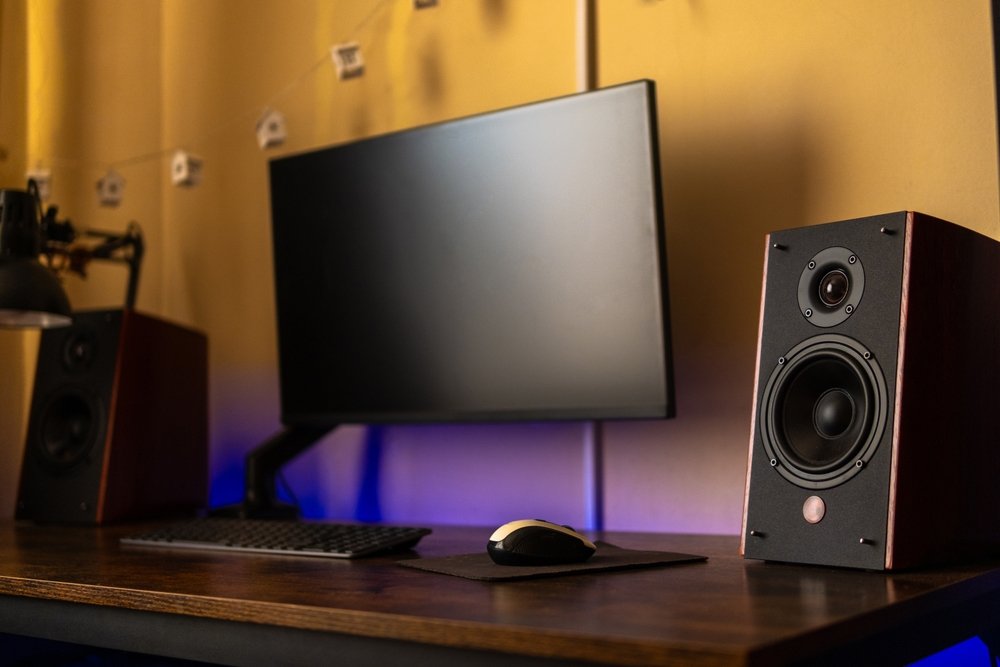Desktop speakers under $200 seriously boost your sound without emptying your wallet. Forget those tinny old computer speakers from 2005. Today’s affordable options pack features you’d expect from pricier gear.
TL;DR: Quick Speaker Recommendations
For most users, the Edifier R1280DB ($129) strikes the best balance with warm, detailed sound, optical/Bluetooth connectivity, and a wood finish. Gamers should choose the Razer Nommo V2 Pro ($149) for THX Spatial Audio and precise directional cues, while minimalists will love the Creative Pebble Pro ($60) for its USB-powered compact design and RGB flair. Prioritize these features:
- Sound: Clarity > bass (unless gaming/EDM).
- Connectivity: Match devices (e.g., optical for PS5, USB-C for laptops).
- Size: Measure desk depth—under 5″ deep for cramped spaces.
- Extras: Subwoofer output for future upgrades, EQ for tuning.
Key Features to Consider Before Buying
Sound Quality: Clarity or Bass?
Your first big pick is 2.0 vs 2.1 speakers. Two-channel (2.0) setups shine with clear vocals and distinct instruments. They’re ideal for podcasts, calls, and acoustic tunes. Adding a sub (2.1) delivers deeper bass for bigger movie booms or punchy EDM. But, smaller satellites can sometimes mean less clear midrange. Check frequency specs: good 2.0 models hit around 55-60Hz, while subs go lower to 40-50Hz, though you might notice gaps where sounds meet.
Connectivity: How You’ll Plug In
Bluetooth desktop speakers are super handy, though sound takes a small hit. Newer codecs like aptX help, but wires still sound best for serious listening. USB is neat for power and sound in one cable. Optical input handles high-res audio cleanly. RCA jacks connect older gear or turntables. Having multiple inputs is really useful – switch between phone, computer, and TV easily.
Size & Shape: Fitting Your Space
Finding speakers for small desks means checking measurements. Tiny models fit almost anywhere but sound narrower. Bigger, bookshelf-style speakers need space but fill a room better. Remember your desk depth, monitor stand, and keyboard. Angled drivers are smart – they aim sound at your ears, not your chest, saving space and improving clarity.
Extra Bits: Lights, Bass, Controls
RGB lighting splits opinions. Many gaming speakers offer flashy, customizable lights that match your setup vibe. Others find them distracting while working. A subwoofer output on 2.0 speakers is great for adding bass later. EQ controls help tweak sound for your room or taste.
Brand & Backup
Stick with known audio brands for better long-term help. Companies like Creative, Logitech, and Edifier often update drivers and offer parts. Newer brands might vanish, leaving software unusable. Warranty length matters too. Two years is a good sign they’ll last.
Top 7 Desktop Speakers Under $200 (2025 Edition)
Creative Pebble Pro
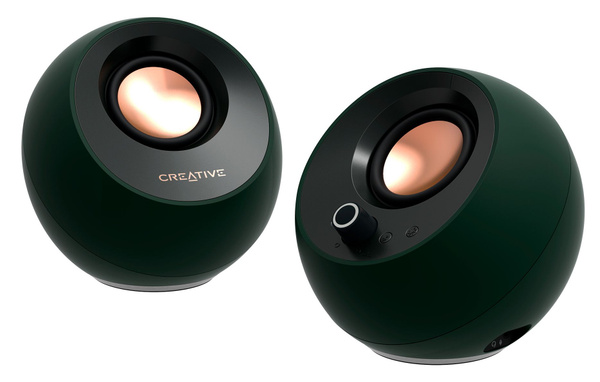
Overview: These spherical speakers pack 2.25-inch drivers into 4.8″ cubes. RMS wattage hits 10W standard, 30W with optional PD adapter. USB-C power eliminates wall adapters.
Performance: Crisp mids and highs dominate the sound signature. Minimal distortion up to 78% volume makes them ideal for vocals and acoustic genres. BassFlex technology extends low-end response despite compact size.
Best For: Tiny desks, dorm rooms, or anyone wanting USB-powered simplicity.
Pros:
- Budget-friendly at $60 with RGB lighting
- Bluetooth 5.3 plus 3.5mm aux input
- 45° angled drivers project sound at ear level
Cons:
- Bass lacks depth below 80Hz
- No subwoofer output for future expansion
Logitech Z407
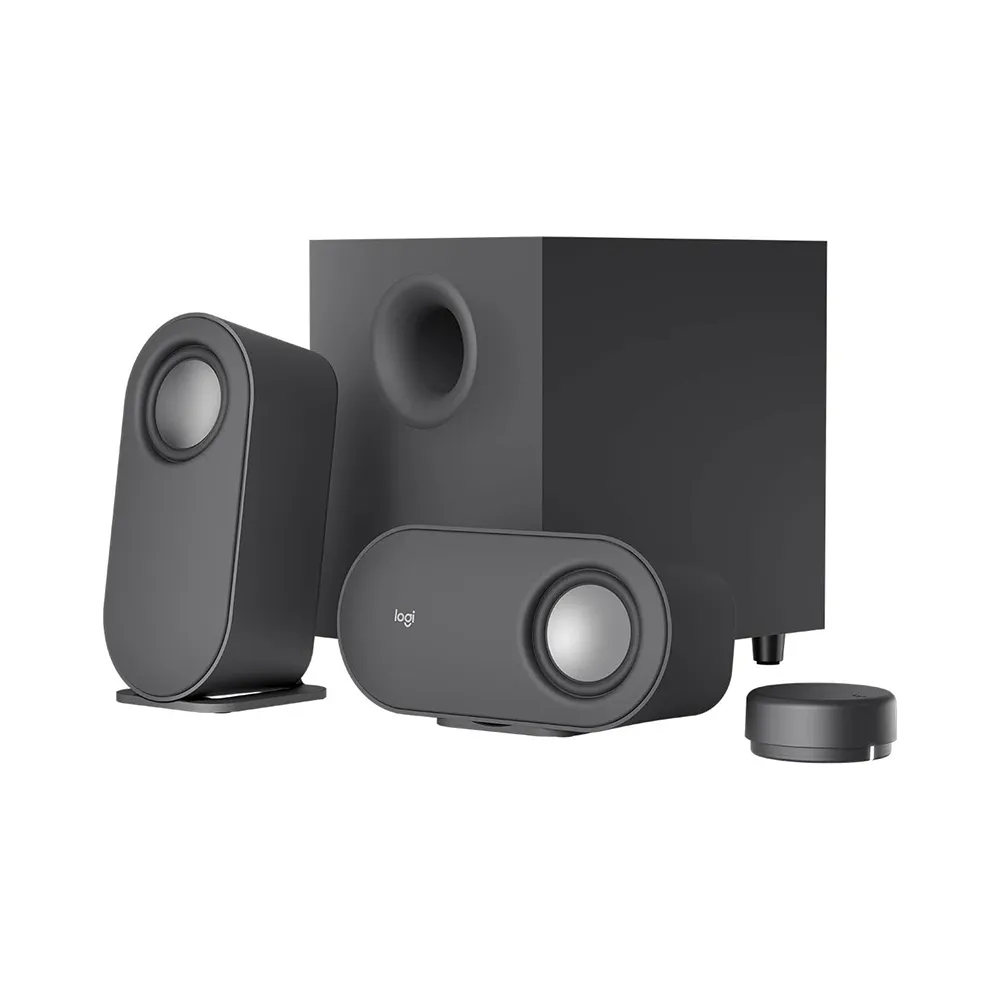
Overview: This 2.1 system combines oval satellites with a 6-inch down-firing subwoofer cube. 80W peak power handles demanding content. Connectivity includes Bluetooth, micro-USB, and 3.5mm.
Performance: Movie theater quality bass reproduction excels with explosions and EDM tracks. Wireless control puck allows volume and bass adjustments from 20 meters away.
Best For: Gaming, movies, and bass enthusiasts who want deep bass for gaming.
Pros:
- Satellites mount vertically or horizontally
- Down-firing sub minimizes desk vibration
- Clean wireless control eliminates cable clutter
Cons:
- Midrange clarity weaker than dedicated 2.0 systems
- Plastic construction feels lightweight despite good sound
Edifier R1280DB
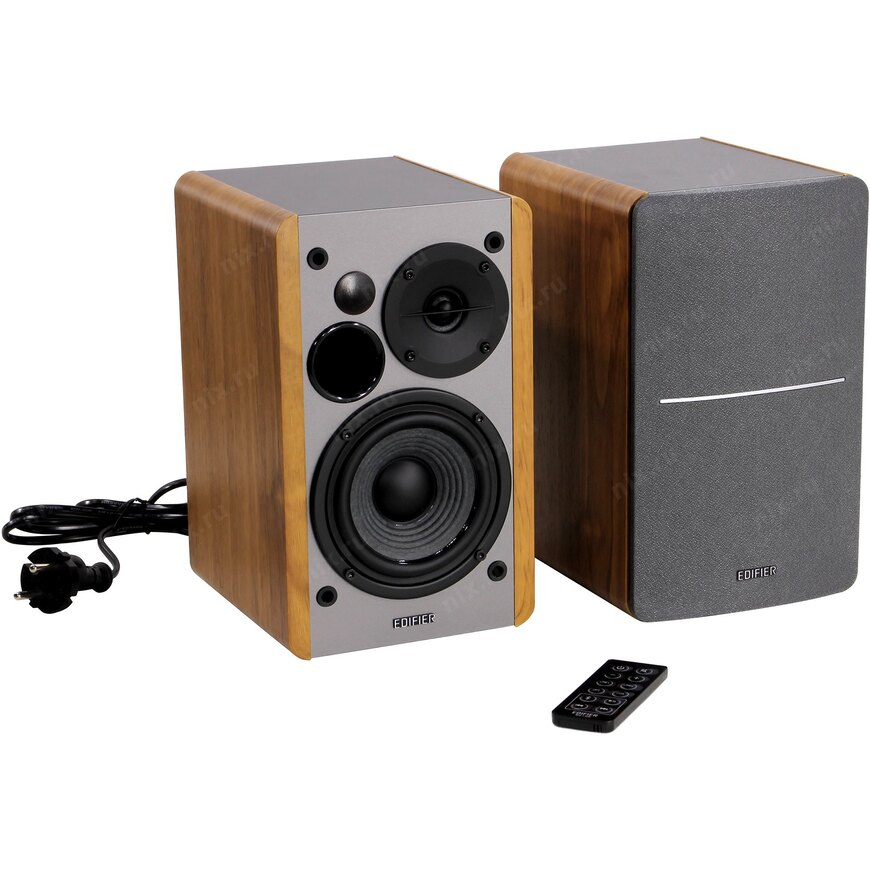
Overview: Classic bookshelf design measures 6.7″ x 9.8″ x 7.3″ with wood veneer finish. 42W RMS power drives quality components. Inputs include optical, RCA, and Bluetooth 5.0.
Performance: Warm, balanced sound signature with pronounced midrange. 55Hz-20kHz response excels with jazz and podcasts. High-fidelity budget speakers that punch above their price class.
Best For: Music production, vinyl setups, and mid-sized desks where aesthetics matter.
Pros:
- Optical input connects TVs and consoles directly
- Remote control plus physical bass/treble adjustment knobs
- Classic wood aesthetic complements any decor
Cons:
- Larger footprint requires adequate desk space
- No USB input limits connectivity options
Mackie CR3-X BT
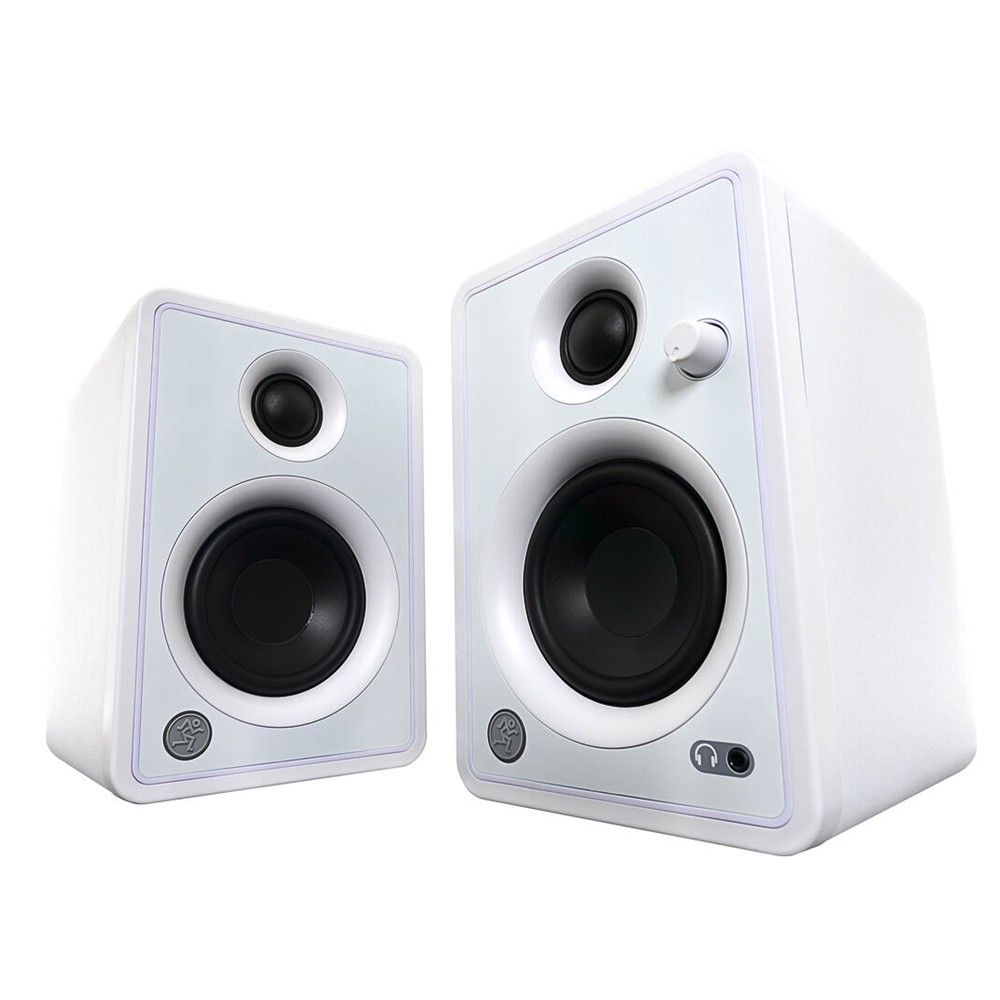
Overview: Studio monitors under $200 with 3.5-inch woofers in 5.5″ x 7.1″ x 8.1″ cabinets. 50W power output. Features toggle between “Flat” studio mode and “Fun” gaming EQ.
Performance: Reference-grade accuracy for mixing applications. Bass remains tight but non-boomy with 69Hz-20kHz response. THD (total harmonic distortion) stays minimal across the volume range.
Best For: Audio editing, critical listening, and minimalist professional setups.
Pros:
- Front-panel headphone jack for private monitoring
- Bluetooth 5.0 plus professional 1/4-inch TRS inputs
- Zero hiss at low volumes maintains quiet studio environment
Cons:
- No dedicated subwoofer output without CR8SBT add-on
- Matte finish shows scratches easily with regular handling
Razer Nommo V2 Pro
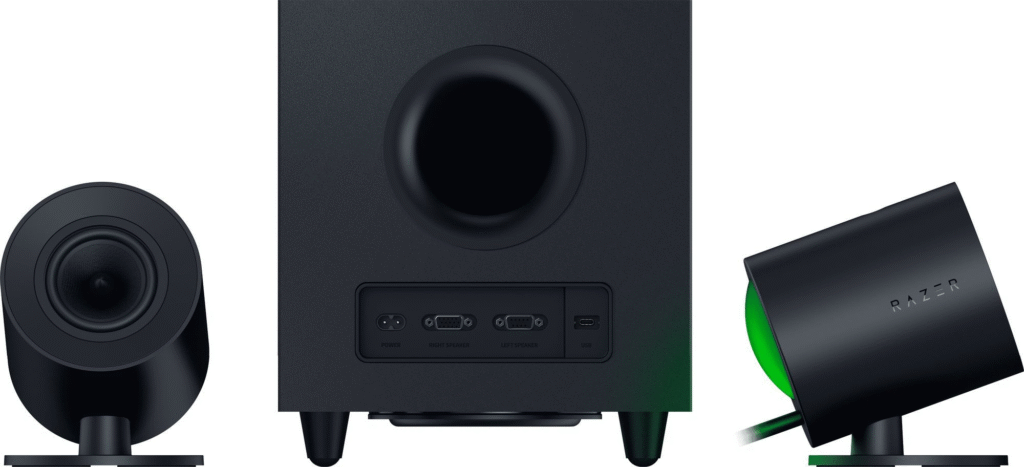
Overview: Gaming-focused 2.0 system in 7.9″ x 5.1″ x 6.7″ form factor. Custom-tuned drivers deliver 40W power. THX Spatial Audio processing enhances directional cues.
Performance: Directional audio excels in FPS games where positional accuracy matters. Voices remain clear while bass stays punchy without overwhelming detail. Gaming speakers optimized for competitive advantage.
Best For: Competitive gaming and RGB-centric battlestations requiring visual flair.
Pros:
- Companion app provides extensive EQ preset options
- HDMI-ARC connects consoles directly
- Built-in cable management clips organize desktop wiring
Cons:
- Higher price point at $149 limits budget appeal
- Near-field optimization reduces effectiveness at distance
Creative Pebble X Plus
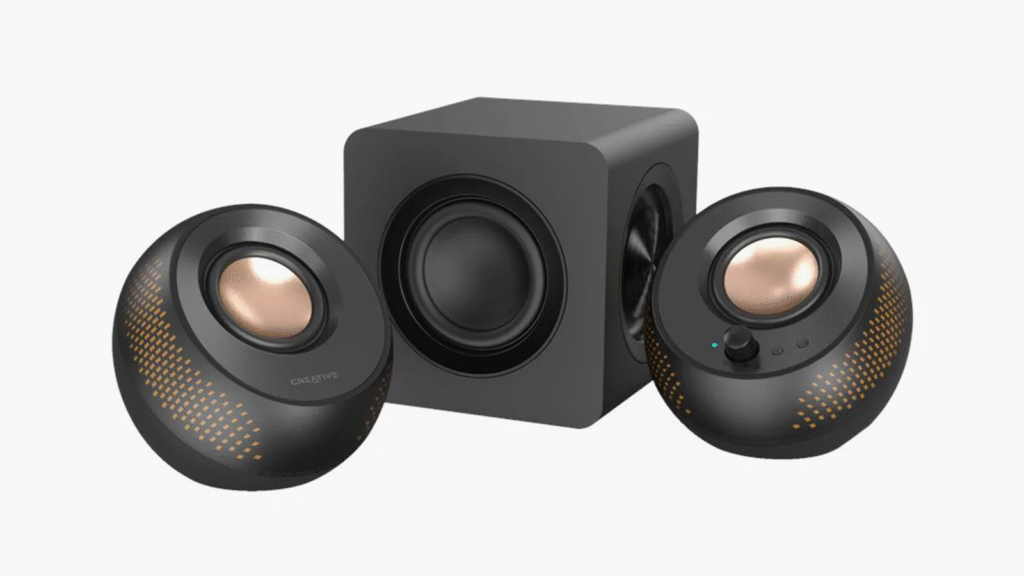
Overview: 2.1 system pairs 4-inch satellites with 5-inch subwoofer. 60W RMS handles demanding content. USB-C and Bluetooth 5.3 provide modern connectivity.
Performance: Shockingly strong bass extension down to 50Hz. Handles action games and hip-hop tracks smoothly without distortion up to 85% volume. Compact computer audio with surprising low-end punch.
Best For: Small rooms and bass lovers seeking maximum impact per dollar at $110.
Pros:
- Compact subwoofer fits under most desks
- Physical volume and bass adjustment knobs
- Distortion remains minimal at high listening levels
Cons:
- Satellites lack tilt adjustment for optimal positioning
- Missing optical input limits high-resolution source compatibility
Onkyo Creator Series GX-30ARC
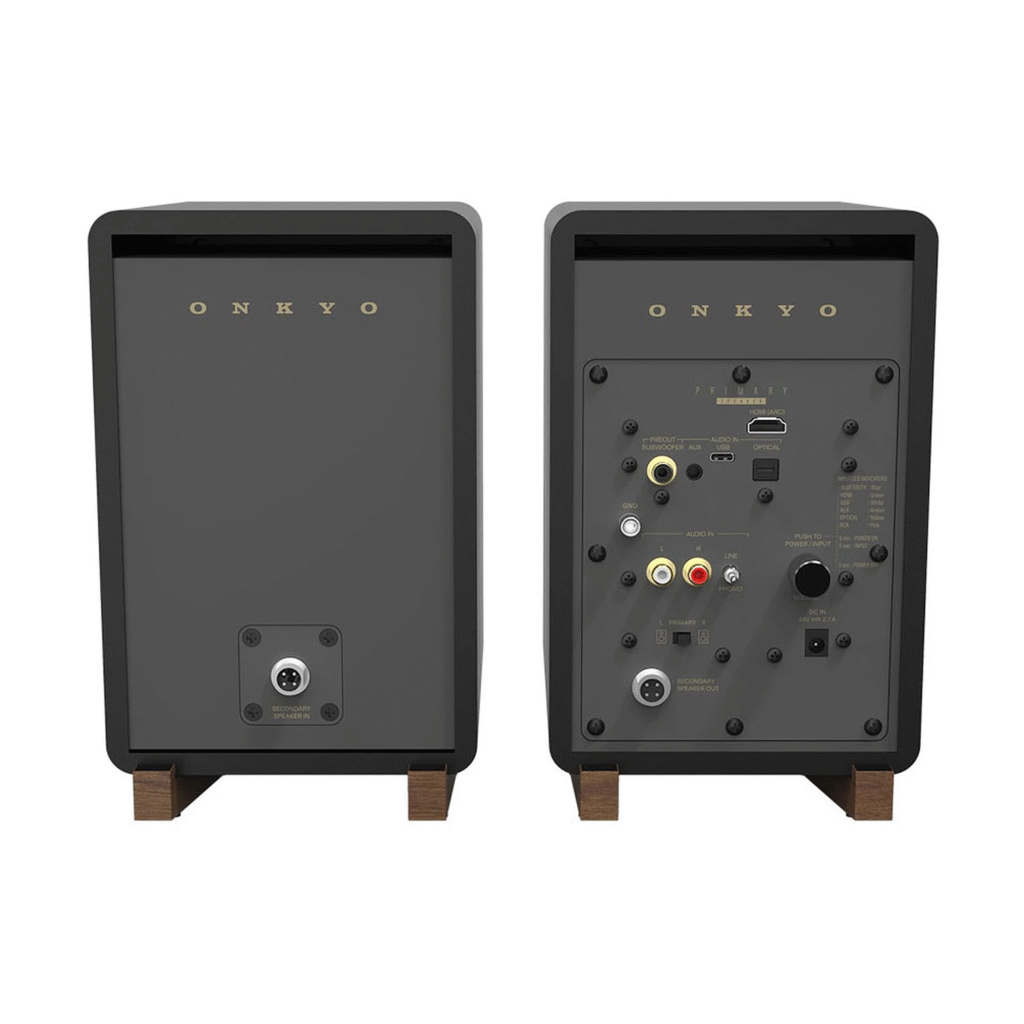
Overview: Hi-fi 2.0 speakers measuring 5.75″ x 8.7″ x 6.7″ with 50W RMS output. Six simultaneous inputs include HDMI ARC, USB-C, optical, RCA, and phono MM.
Performance: Neutral, detailed soundstage handles orchestral complexity and dialogue with equal finesse. Signal-to-noise ratio remains excellent across all input types. Crisp vocals for Zoom calls and professional applications.
Best For: Multi-device setups connecting TVs, turntables, and consoles simultaneously.
Pros:
- Built-in phono preamp eliminates external vinyl equipment
- Dedicated subwoofer output port enables future expansion
- Six inputs eliminate constant cable swapping
Cons:
- Bulky dimensions challenge small desk configurations
- Proprietary speaker cables complicate replacement
Side-by-Side Comparison
| Model | Price | Power (RMS) | Connectivity | Frequency Response | Special Features |
| Creative Pebble Pro | $60 | 10W | BT 5.3, USB-C, 3.5mm | 80Hz–20kHz | RGB, USB-powered |
| Logitech Z407 | $99 | 80W (peak) | BT, micro-USB, 3.5mm | 55Hz–20kHz | Wireless control puck |
| Edifier R1280DB | $129 | 42W | Optical, BT 5.0, RCA | 55Hz–20kHz | Wood finish, remote |
| Mackie CR3-X BT | $130 | 50W | BT 5.0, 1/4″ TRS, RCA | 69Hz–20kHz | Studio/gaming EQ modes |
| Razer Nommo V2 Pro | $149 | 40W | HDMI ARC, USB, 3.5mm | 70Hz–20kHz | THX Spatial Audio, app control |
| Creative Pebble X+ | $110 | 60W | BT 5.3, USB-C, 3.5mm | 50Hz–20kHz | Mini subwoofer included |
| Onkyo GX-30ARC | $179 | 50W | HDMI ARC, USB-C, optical, RCA | 50Hz–20kHz | Phono preamp, 6 inputs |
FAQ
Are $200 speakers much better than $50 ones?
Yes, definitely. Desktop speakers under $200 offer better build, nicer parts, and more ways to connect. But the jump feels bigger going from $50 to $100 than from $100 to $200. Cheap ones often use plastic and basic drivers. Mid-priced models add stuff like MDF wood, stronger magnets, and better crossovers. This means cleaner sound and they last longer.
Can I add a subwoofer later to 2.0 speakers?
Sometimes. A few 2.0 speakers have special outputs just for a sub. Models like Onkyo GX-30ARC or Mackie CR3-X let you do this. Others need splitter cables, which can make sound worse. You could also use an active sub that connects straight to speaker wires, but getting the volume right is tricky to avoid sound gaps.
Do I need a DAC for these?
Probably not. Most computers have decent enough sound built-in. Only get one if you hear noise, distortion, or weird sounds now. Speakers using USB skip the computer’s sound chip entirely, which often cuts down on electrical noise. Optical connections do the same thing.
How important is wattage?
Less than you might think. Clean sound at 10 watts beats messy sound at 50 watts any day. You just don’t need huge power sitting at a desk. Look at the RMS rating, not the peak number. RMS tells you the real, steady power it handles.
Bluetooth vs. wired: What sounds better?
Wired wins for pure quality. USB, optical, or analog jacks skip the compression Bluetooth needs. People who really care about sound notice this difference. Newer Bluetooth like aptX or LDAC helps close the gap. For everyday listening, the wireless convenience is usually worth the tiny drop.
What size works best on a small desk?
Look for compact ones under 5 inches wide. Stuff like Creative Pebble makes good sound without hogging space. Bigger bookshelf speakers need at least 24 inches of width for proper stereo sound. Measure your desk first if considering those.
Do cheap desktop speakers work with PS5 or Xbox?
Usually, yes. Most connect through the controller’s headphone jack or the console’s optical output. A few, like Razer Nommo V2 Pro or Onkyo GX-30ARC, have HDMI-ARC for direct hookup. Heads up: USB-powered speakers might not get enough juice from a console port – a wall adapter fixes that.


